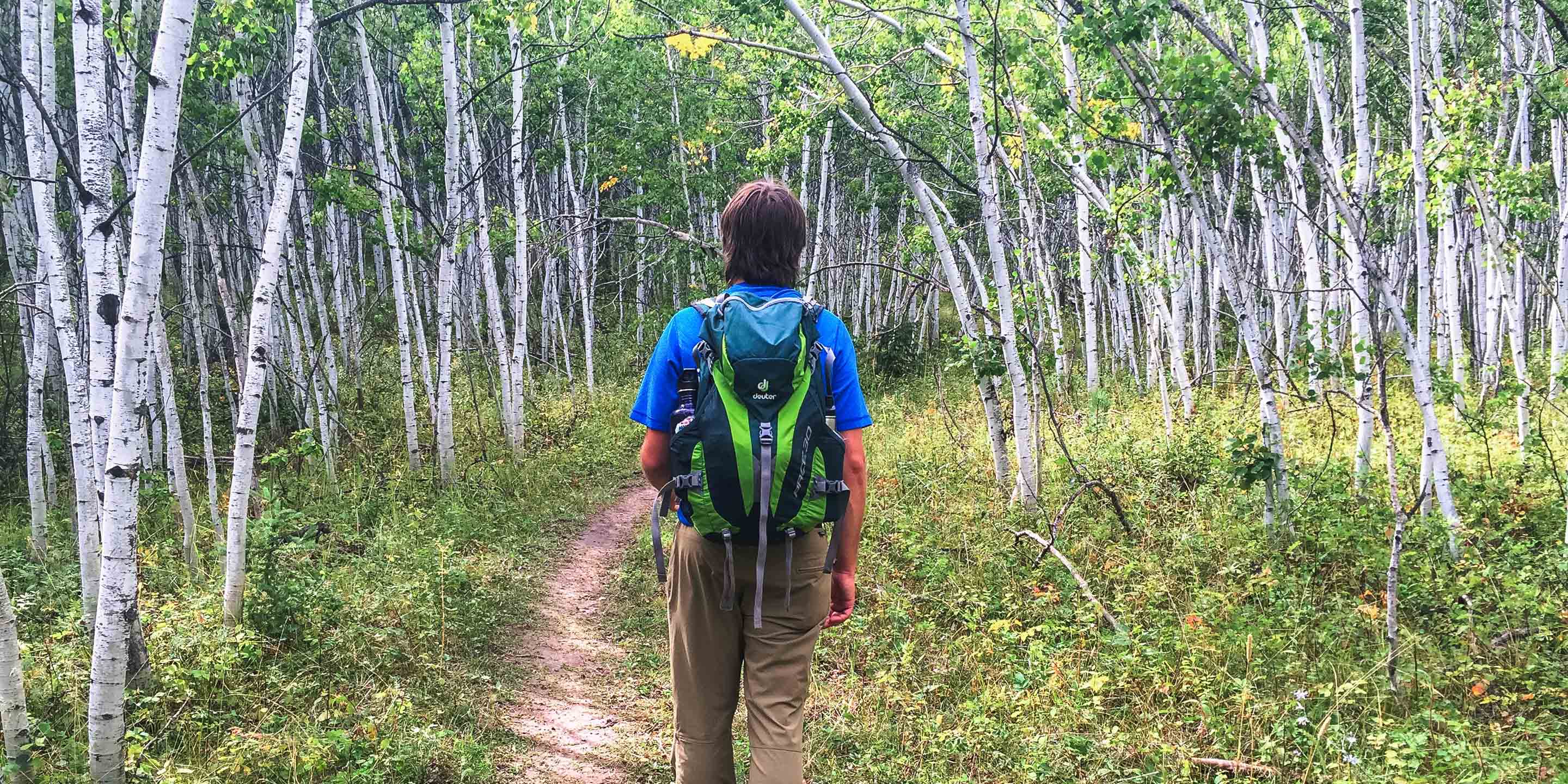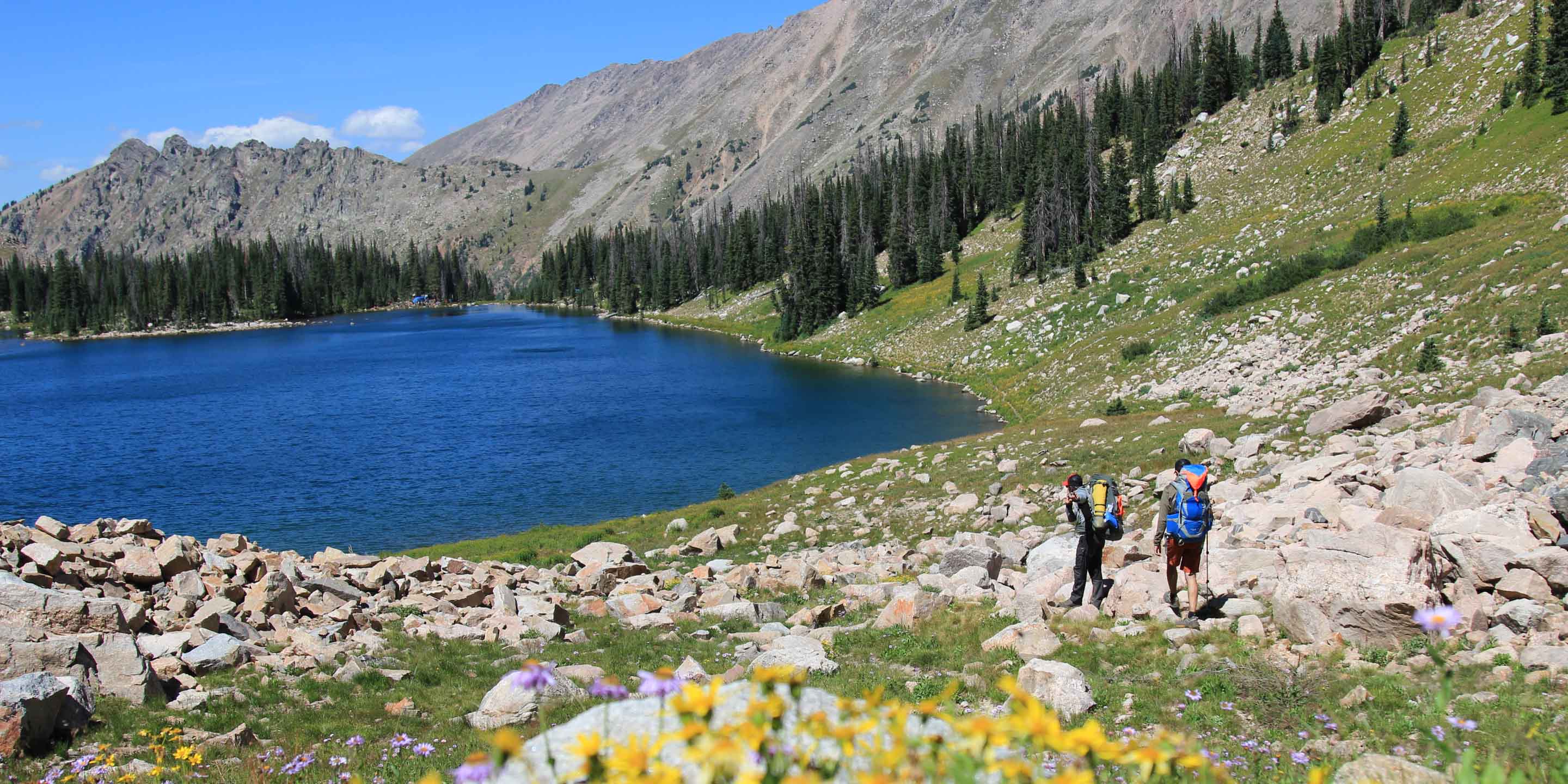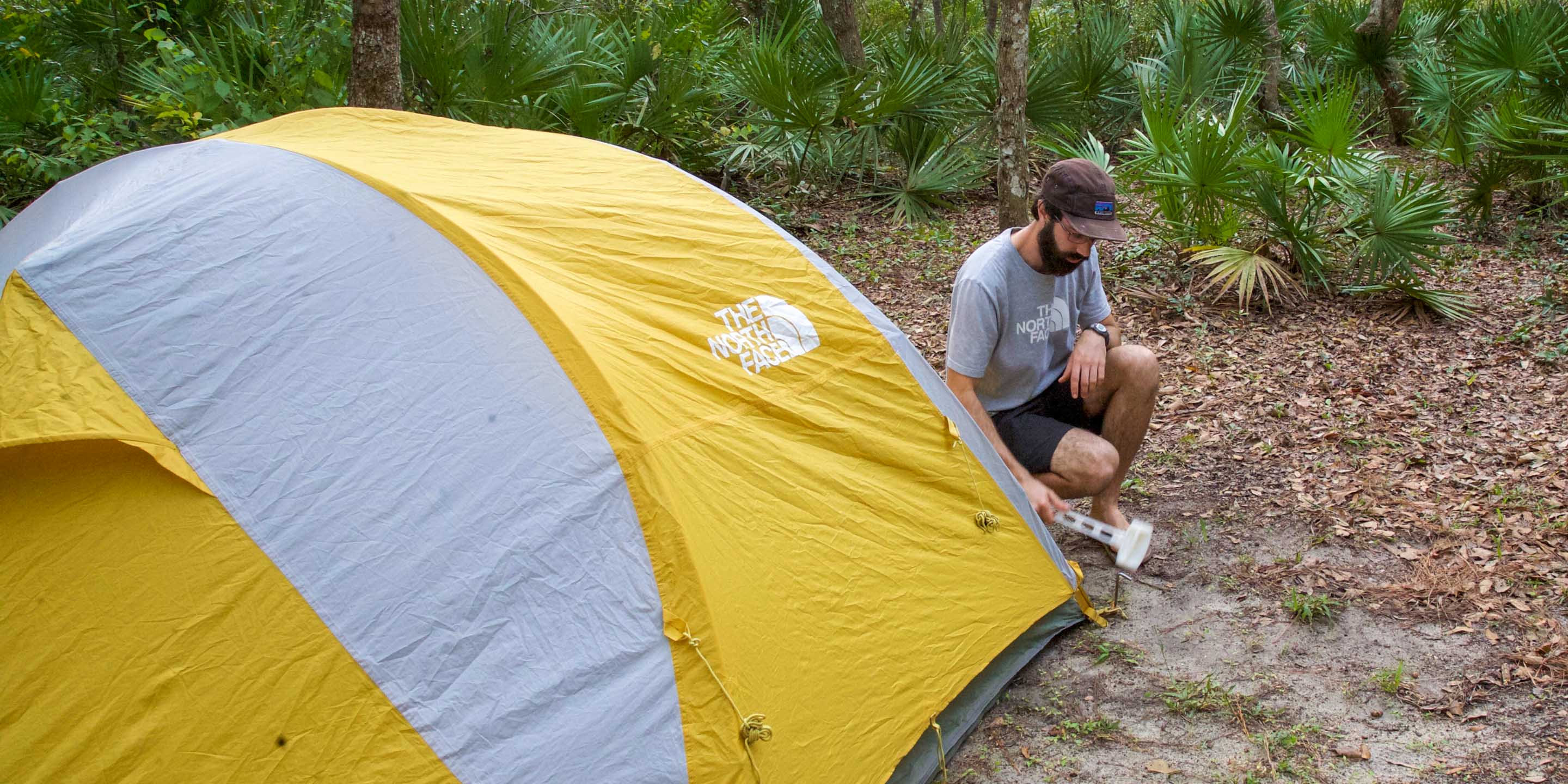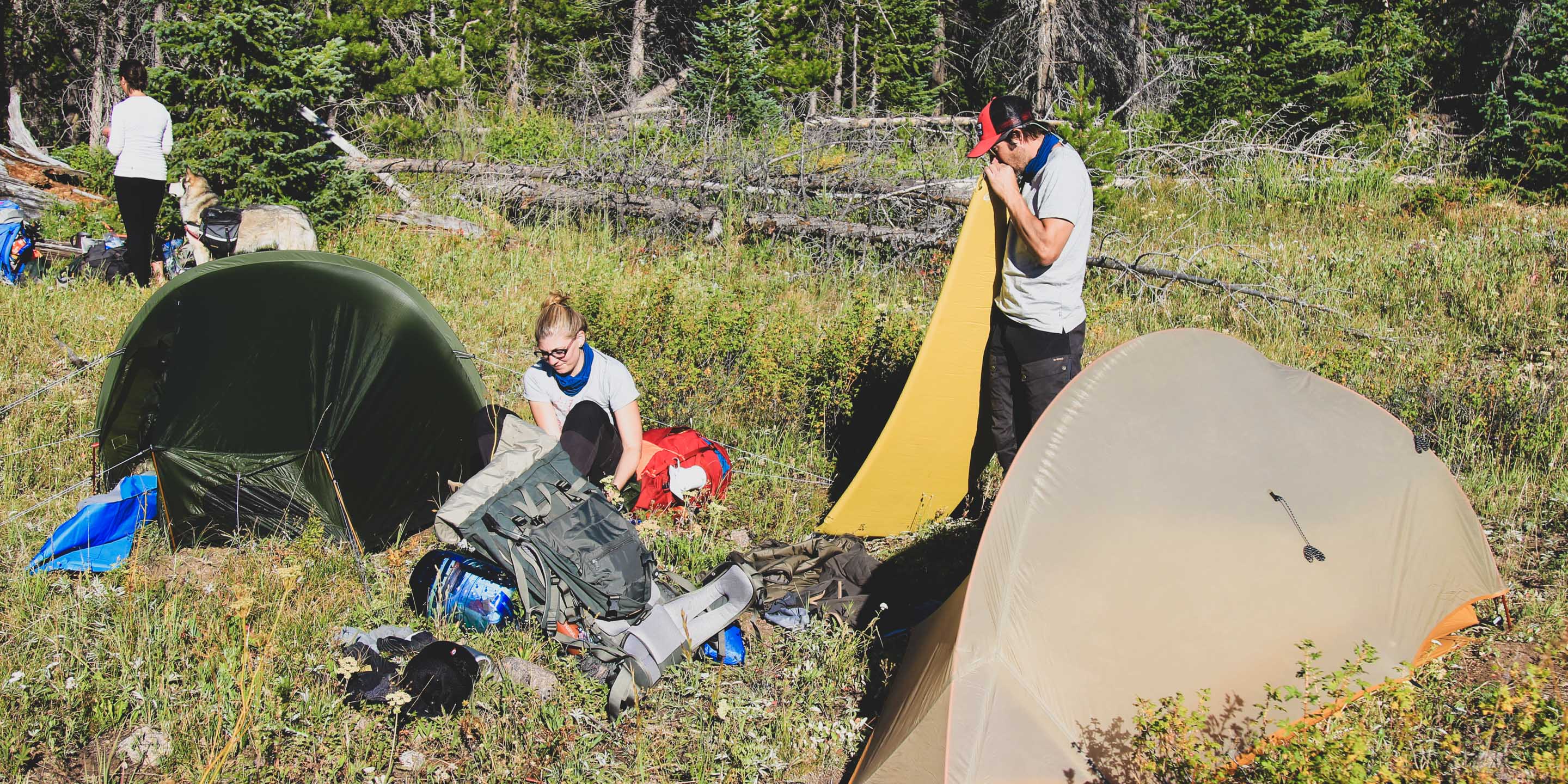How To Clean Debris From Ravel Paths
Principle 2: Travel & Military camp on Durable Surfaces
The goal of travel in the outdoors is to move through natural areas while avoiding harm to the land or waterways. Understanding how travel causes impacts is necessary to achieve this goal. Travel damage occurs when surface vegetation or communities of organisms are trampled beyond recovery. The resulting barren surface area leads to soil erosion and the development of undesirable trails. Backcountry travel may involve travel over both trails and off-trail areas.
Travel on Trails
Land management agencies construct trails to provide identifiable routes that concentrate foot and stock traffic. Constructed trails are themselves an impact on the land; nonetheless, they are a necessary response to the fact that people travel through natural areas.
Concentrating travel on trails reduces the likelihood that multiple routes volition develop and scar the landscape. It is better to accept one well-designed route than many poorly chosen paths. Trail utilize is recommended whenever possible. Encourage travelers to stay within the width of the trail and not shortcut trail switchbacks (trail zigzags that climb hillsides).
Travelers should provide infinite for other hikers if taking breaks along the trail. The principles of off-trail travel should exist skilful if the decision is fabricated to move off-trail for breaks. Hikers in the same group should periodically stop to residual and talk. Avoid shouting to communicate while hiking. Loud noises usually are not welcome in natural areas.

Travel Off-trail
All travel that does non use a designed trail such as travel to remote areas, searches for bathroom privacy, and explorations near and effectually campsites is divers as off-trail. Ii primary factors increase how off-trail travel affects the land: immovability of surfaces and vegetation, and frequency of travel (or group size).
- Durability refers to the ability of surfaces or vegetation to withstand wear or remain in a stable condition.
- Frequency of use and big group size increase the likelihood that a large surface area will be trampled, or that a small-scale area volition be trampled multiple times.
Surface Immovability
The concept of durability is an of import 1 for all backcountry travelers to understand. The natural surfaces described below respond differently to backcountry travel.
Rock, sand and gravel: These surfaces are highly durable and tin tolerate repeated trampling and scuffing. (However, lichens that grow on rocks are vulnerable to repeated scuffing).

Ice and snow: The consequence of travel beyond these surfaces is temporary, making them good choices for travel assuming good prophylactic precautions are followed and the snow layer is of sufficient depth to foreclose vegetation damage.
Vegetation: The resistance of vegetation to trampling varies. Careful decisions must exist made when traveling across vegetation. Select areas of durable vegetation, or thin vegetation that is easily avoided. Dry grasses tend to be resistant to trampling. Moisture meadows and other fragile vegetation quickly show the furnishings of trampling. Trampling ensures new travelers to take the same route and leads to undesirable trail derailment. As a general rule, travelers who must venture off-trail should spread out to avoid creating paths that encourage others to follow. Avoid vegetation whenever possible, especially on steep slopes where the effects of off-trail travel are magnified.
Living soil: Sometimes referred to as ͞cryptobiotic crust,͟ or ͞crypto,͟ living soil is often establish in desert environments, and is extremely vulnerable to foot traffic. Living soil consists of tiny communities of organisms that appear as a blackish and irregular raised crust upon the sand. This crust retains moisture in desert climates and provides a protective layer, preventing erosion. Ane pace can destroy this fragile soil. It is important to use developed trails in these areas. Travel across living soil should only be done when absolutely necessary. Walk on rocks or other durable surfaces if you must travel off-trail. In wide areas of living soil where harm is unavoidable it is best to follow in one another's footsteps so the smallest expanse of crust is affected, exactly the reverse rule from travel through vegetation. Living soil is also extremely vulnerable to mountain bicycle travel.
Desert puddles and mud holes: H2o is a preciously deficient resource for all living things in the desert. Don't walk through desert puddles, mud holes or disturb surface water in any mode. Potholes are also habitation to tiny desert animals.
Camp on Durable Surfaces
Selecting an appropriate campsite is perhaps the nigh important aspect of depression-impact backcountry use. It requires the greatest caste of judgment and information, and often involves making merchandise-offs between minimizing ecological and social impacts. A decision virtually where to camp should be based on information about the level and type of utilize in the area, the fragility of vegetation and soil, the likelihood of wild fauna disturbance, an assessment of previous impacts, and your party'due south potential to cause or avert impact.

Choosing a Camp in Loftier-use Areas
Avoid camping close to h2o and trails, and select a site which is non easily visible to others. Even in popular areas, the sense of solitude tin be enhanced by screening campsites and choosing an out-of-the-way site. Camping 200 feet (70 adult steps) away from the water's border is recommended because information technology allows access routes for wild animals. Be sure to obey regulations related to camp pick. Let plenty time and energy at the end of the day to select an advisable site. Fatigue, bad weather, and tardily departure times are non acceptable excuses for choosing poor or fragile campsites. Generally, it is best to camp on sites that are and so highly impacted that further careful use will cause no noticeable impact. In popular areas, these sites are obvious because they have already lost their vegetation cover. Besides, it is ofttimes possible to observe a site which naturally lacks vegetation, such every bit exposed bedrock or sandy areas.
For loftier-touch sites, tents, traffic routes and kitchen areas should be full-bodied on already impacted areas. The objective is to confine touch on to places which already show use and avoid enlarging the expanse of disturbance. When leaving campsite, make sure that information technology is clean and highly-seasoned for other campers who follow.
Camping in Undisturbed Remote Areas
Pristine areas are ordinarily remote, see few visitors and evidence no obvious impacts. Visit these special places just if you are committed to, and highly skilled in, Leave No Trace techniques. In pristine places, it is all-time to spread out tents, avoid repetitive traffic routes and motion camp every dark. The objective is to minimize the number of times whatever role of the site is trampled. In setting upwards camp, disperse tents and the kitchen on durable sites. Vesture soft shoes around army camp. Minimize activeness around the kitchen and places where packs are stashed. The durable surfaces of large rock slabs make good kitchen sites. Spotter where you walk to avert crushing vegetation and have alternating paths to water. Minimize the number of trips to water by carrying h2o containers. Ever bank check regulations, but camping 200 feet (70 adult steps) from h2o is a good rule of thumb.

When breaking camp, accept fourth dimension to naturalize the site. Covering scuffed areas with native materials (such as pine needles), brushing out footprints, and raking matted grassy areas with a stick volition assistance the site recover and make it less obvious as a military camp. This extra endeavour volition assist hide whatever indication where you camped and get in less likely that other backcountry travelers volition campsite in the aforementioned spot. The less oftentimes a pristine military camp is used the better take chances it has of remaining pristine.
The most appropriate campsites in arid lands are on durable surfaces, such as rock and gravel, or on sites that take been so highly impacted further apply will cause no additional disturbance. Previously impacted sites are obvious because they take already lost their vegetation embrace or the rocky soils have been visibly disturbed. If choosing this type of site, make sure your spot is large enough to accommodate your entire group.
A pristine campsite, with no evidence of previous apply, is appropriate in arid lands provided it is on a non-vegetated, highly resistant surface. Expenses of stone, gravel or sand are all first-class choices. It should never be necessary to camp on living soil, islands of vegetation or inside the precious green ribbons of desert creeks or streams. Beware when camping ground on sandy river bottoms and areas susceptible to flash floods.
Cooking areas, tents and backpacks should exist located on rock, sand or gravel. Consciously cull durable routes of travel between parts of your camp and so that connecting trails exercise not develop. Vary your routes since the objective is to minimize the amount of trampling and compaction on any specific role of the campsite. Limit your stay to no more than two nights. Never scrape away or clean sites of organic litter similar leaves, and always minimize the removal of rocks and gravel. The organic litter volition assistance to absorber trampling forces, limit the compaction of soils, release plant nutrients and reduce the erosive forces of rainfall. Disturbing the lichen-coated and varnished rocks known every bit desert pavement can leave a visible impact for hundreds of years. In one case overturned, these rocks are difficult to supplant and the lichens and varnish will not grow dorsum within our lifetime.
Camping in River Corridors
River corridors are narrow strips of land and water with little room to disperse man activities. Campsites are often designated. It is generally best to camp on established sites located on beaches, sandbars or non-vegetated sites below the high-water line.
Let'due south protect and enjoy our natural globe together
Go the latest in Exit No Trace eNews in your inbox and so yous can stay informed and involved.
Source: https://lnt.org/why/7-principles/travel-camp-on-durable-surfaces/
Posted by: rodriguezaguied.blogspot.com


0 Response to "How To Clean Debris From Ravel Paths"
Post a Comment